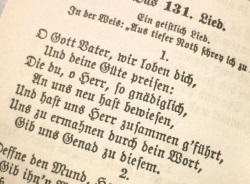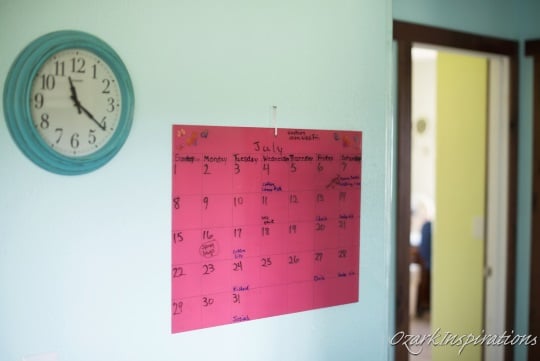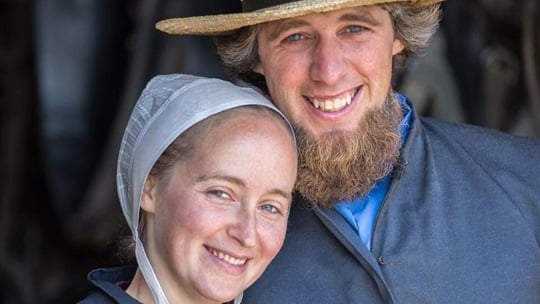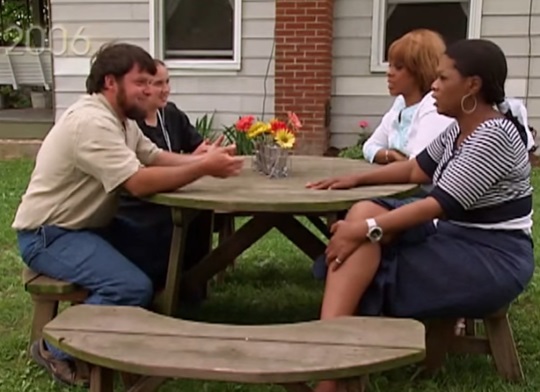Merlyn Yoder: What the Ausbund means to me
Amish author Benuel Blank once wrote that the Ausbund, the centuries-old Anabaptist hymnal, is “not to be considered a holy book like the Bible”, but that it has nonetheless been very influential for Amish and their spiritual kin.
Passing along a description of the book, Blank calls it “music for the soul, rather than music for the ear”. In use since the 1500s, the Ausbund continues to play an essential role in Amish church, providing hymns to both open and close Sunday services.
Merlyn Yoder is a member of an Amish church in northern Indiana. I asked him to share some thoughts on the Ausbund with us today. Merlyn explains how he first learned to sing from the Ausbund, and how the book has come to have special importance in his life and faith.
—
What the Ausbund means to me
The Ausbund. That little black book with about 900 pages. The book we sing from in church. What is it? Who wrote it? Why do we use it? We have always used it as long as I remember. My grandparents sang from it and so did their grandparents. Why should we use anything else?
 I remember as a boy I’d page through that book in church. If I counted the several blank pages I would get just over 900. I couldn’t read most of it. I went to the public school and German was introduced in 5th and 8th grade, but not in depth.
I remember as a boy I’d page through that book in church. If I counted the several blank pages I would get just over 900. I couldn’t read most of it. I went to the public school and German was introduced in 5th and 8th grade, but not in depth.
When I started the 18-week process of joining our church as a member, I would follow along with the singing (I am not a natural singer). As time went on, I began to help. This taught me German pronunciation. Singing with a group was okay but singing by myself was like jumping into deep water and not knowing how to swim. In our church district we have an informal practice session every two weeks. After our marriage I made a concentrated effort to go. I have made progress.
I now know the tunes our district uses fairly well. Different tunes that we use throughout the year stir up specific emotions. Wedding tunes bring joy, the wishing of a blessed life, and the anticipation of the noon meal and socializing. One tune we always use in spring reminds me of the soft south wind, birds singing, dandelions, and the first bumblebees, even when used at other times. Some tunes recall vague memories of being in church at various homes as a boy.
As with many things, if you put in more effort the rewards are greater. In recent years I have been exploring some of the lesser-known hymns. I have discovered quite a few stories of martyr deaths. There are a few Bible stories such as Jesus raising Lazarus from the dead. Several of the Psalms have been reworked to a singable meter.
 The authors were often but not always severely persecuted and executed. This begs the question: Did God have a plan for our people today? This little book was one of the fruits of their great sufferings. It has survived all these centuries, which is proof enough to me that God’s blessing rests upon it. We owe it to our God and forefathers in faith to continue using this book so their sufferings and prayers were not in vain.
The authors were often but not always severely persecuted and executed. This begs the question: Did God have a plan for our people today? This little book was one of the fruits of their great sufferings. It has survived all these centuries, which is proof enough to me that God’s blessing rests upon it. We owe it to our God and forefathers in faith to continue using this book so their sufferings and prayers were not in vain.
While not nearly everyone is as enthusiastic about Ausbund research as I am, there is still ample interest in passing our tunes to the next generation. I am thankful to live where the use of this book is firmly in place for the foreseeable future.
Merlyn, his wife, and six children live in northern Indiana. He has a job in the RV industry and his hobbies include woodworking, working on engines, beekeeping, orcharding, and history – especially the study of the Ausbund.
Learn more about the Ausbund here.









Then you're not . . .
. . . the Merlyn Yoder I thought you might be!
When I went to Catholic high school in Northern Indiana, our school had a director of liturgical music by that name who had grown up in the Amish community but had converted to Catholicism. He is long since gone from the school, and I’ve often wondered what became of him. When I saw your name and saw that this article was about the hymnal, I thought perhaps he’d “converted back.”
But then you mentioned that singing was not your strong suit! The Merlyn Yoder I knew had it as his stock in trade, and in fact had composed some hymns, including a setting of Psalm 50/51 (depending on your numbering) that is still the one I hear in my head when I read the words.
I know half the men from Elkhart and Lagrange counties must be named Yoder. I don’t suppose you happen to know of the one of whom I speak?
Neat coincidence Trish. Merlyn is not online but I’ll try to pass this question on to him. I think the “y” spelling of his name is less common than “i”.
And perhaps the “i” spelling is the right one for the man I knew when I was young.
Thanks for passing along my query! Again, I don’t expect every Yoder to know eery other Yoder in these parts, but perhaps having the same name, he will have at least heard the “are you any relation to …” question before.
My apologies if the fact that he is not Amish (or wasn’t when I knew him) is a sore spot. But I knew him as a kind, gentle Christian who helped many young Christians put our love of God into song, and I hope that even as a Catholic, that is something an Amish relative would be glad to hear of.
Trish
I would love to page thru an Ausbund.. and hear the Amish sing the songs from it.. It has no music scores in it… only words. Is this correct?
That’s correct Kim. There are a couple of photos from the interior and a translation of the “Lob lied” hymn at the link I included at the end. But it’s another book you can purchase inexpensively if you’d like a copy.
There is something very wonderful about singing hymns from a book in use since 1500.
KimH and forsythia;
That is the fascinating thing about the Anabaptist, Amish and Mennonite musical tradition, in groups like the Amish there might not be a written notation on what music to play with the lyric, because the Amish do not use musical instruments in church service, as we know, but everyone knows the sound that they are to sing. I’ve never heard Amish church music live, but I imagine everyone knows it, it is by now ingrained in everyone involved, so much so that they probably don’t need a book, but they still use one to be sort of standardized. I would imagine its a bit like nursery rhyme songs or other children’s songs that goes back literally ages (centuries), everyone knows them but the notation on how the music is to be song might not have been written down (sure some have, but everyone knows how certain things go, I would hazard a guess the same is true of the Ausbund)
Although I’m not a regular church goer of my English faith traditions, faith and cultural music of the sort is interesting, two “uncles” of mine have in the long course of my collective family had notoriety (positive and negative among their “friends”) in terms of cultural and faith music, both men, so I hear supervised the music of their respective churches in their eras (the early 1800s and the 1930s into the 40s) one guy apparently created a bit of a “Ausbund” sort of collection for his own use of his ethnicity’s faith and cultural music for use in the church, outside in the broader community and for his family’s enjoyment (it stayed in the family some how, but my Aunt, his niece, doesn’t know who, if anyone still possess the collection in our family or if not knowing what it was, it got trashed, which would be sad).
Going back to the Ausbund, I really enjoy listening to the videos of Amish people singing that have been shared over the years. I can see how it is uplifting to them.
The Ausbund
In our old order Mennonite communities, we never used the Ausbund, but I believe our German song book has some of the Ausbund lieder.
In our branch of the old order church, we dropped English singing thirty years ago in favour of an old Mennonite hymnal, still without notes, dating from the height of the Fundamentalist movement among Mennonites. The songs have a different emphasis from the Ausbund, and as a song leader for thirty years, I got frustrated with the book we were using. I believe our use of English materials has left us with an influence that has somewhat drawn us away from our Anabaptist roots.
I have a 1940 copy of the Ausbund
Originally it belonged to a dear friend of the family. She scribbled notes to herself both front and back of the book about various songs. It is falling apart now but if I knew someone who would treasure it for a long time to come I would have it rebound.
I grew up Amish and the songs can still make my heart ache. In the Amish church, as opposed to the Mennonites, songs are sung in unison rather than with harmonies but the blend of male and female voices as they sink and soar is lovely. I used to listen particularly to my mother and her best friend’s voices. Mom’s voice was warm and textured while Anna’s (the friend whose Ausbund I now have) was silvery and pure.
A few songs were sung to different tunes and with different rhythms. Since all songs were led by a single voice, with the congregation joining in on the second or third word, that voice set the tune, the key and the speed.
Ben Blank
Ben was my Father.
Thanks for mentioning him.
I knew your father, S., and thought a lot of him. His book “The Amazing Story of the Ausbund” is a very well done book, interesting and very informative.
How nice to hear that, S. I quoted a good bit from yourfather’s book on the Ausbund in the other post I linked above. https://amishamerica.com/ausbund/
I enjoyed his writing style and of course the good information he delivered. Thanks for commenting.
What the Ausbund means to a person not Amish
I was saved at 16. I was Catholic. I began reading the Bible and was Re Baptized at 20 years old in the Tangipahoa River in Louisiana. It was a time of great revival and The Lord saved thousands most of whom were Catholic and were Re Baptized. Our zeal and passion for The Lord lead our Churches into all the world with the Gospel. We are and many more in previous generations Anabaptists in the true sense of the title. The Ausbund is the greatest remaining testimony of the real work of God in the hearts of lost men, a work of Salvation that made people willing to lay down their lives for the Gospel. We seek God to move again and save to the uttermost. And let us sing as from the Ausbund with hearts fully consumed with the Presence of The Lord and by His grace serving Him and loving one another.
My dad wrote the music note books for the Ausband for northern Indiana and lower Michigan so that it’s easier to remember how songs are to be sung.
There is a display on the history of the Ausbund as well as copies of each edition from 1564 to the 2011 printing. I say “each” — there are six copies missing and their places in the display are marked by wooden copies made to look like the original. It is well worth checking out! This is at “Behalt,” or “The Amish & Mennonite Heritage Center” here in Holmes Co. just outside Berlin. Anyone with an interest in Amish history or culture should make a stop there. The Ausbund display is just a small part of what there is to do and see there. They do have a website.
For me the Ausbund is the song-book we use in church and there are certain hymns (Such as “Lebt Friedsam”) that always hit my emotions. Though I enjoy the faster singing done in parts at other times, there is such a strength is hearing the whole church sing in unison.
I heard a very interesting statement recently: There are about 2,200 Amish church districts in North America today, so on any given Sun. forenoon, services are being held in 1,100 different Amish houses, shops or barns. Since we all sing the Loblied as the second hymn, when that hymn begins, we can know it is being sung in about 1,100 different homes. (though of course time zones will make a difference!) There is a strength in that…
Don’t overlook the historical information written in the back of the book, either. It makes interesting reading.
Power of Amish song
Mark I basically have little to no idea what the words mean, but your description of hearing the whole church sing as one as emotional struck a chord (pun intended, ha-ha).
In seriousness, I’ve been to maybe 10 or so Amish church services in different communities, and every time they start into that very first song it gives you a tingle. It must have an even deeper level of power when you are in fact a church member and can understand the meaning of the words, and sing along as a member with your people.
songs in two languages
Erik: You and others who desire to know the words to some of the German songs sung by the Amish could find a Christian Hymnary book. Around page 400 I believe, you find many songs with both the German and English stanzas. Beware, they are not always totally accurate translations of the German, since the composer sometimes tried to make the stanzas rhyme and sacrificed the literal meaning of the words for a close comparison. Hope that helps you appreciate the songs!
To those having computers amish singing is on U2.
https://www.youtube.com/results?search_query=amish+singing+Gott+ist+die+liebe
Working in the children’s dept. of a library, I’ve heard many versions of children’s songs. There seems to be a recurring use of a certain melody—Baa Baa Black Sheep, the Alphabet Song, Twinkle, Twinkle Little Star…maybe others. This came to mind when reading about the Ausbund and how the melodies of hymns in it get passed down through the generations so that everyone in the church district (many districts, if not all) knows the “right” melody for each song.
I wonder, do some songs in the Ausbund “share” the same melody, like the nursery rhyme “songs” I’ve mentioned above? Where did those melodies first come from (possibly from other Christian traditions’ hymns’ melodies?). Just curious, as usual.
Alice Mary
Some of the songs have a tune name printed underneath, but all the tunes can be found in a register at the back. Some songs can be sung on various tunes. #156 in the Liedersammlung (which is not just for church but school, singings, and social gatherings) can be sung on at least 80 different tunes. In the Ausbund, at least a few of the tunes appear to come from secular sources but oral tradition has it the tunes were “slowed down” or modified.
Tunes vary from group to group, too, by the way, so we can hear when a certain song is led by someone from Lancaster, PA, instead of someone local. We can recognize the tune, but there will be some slight variations.
Question for Osiah Horst
Mr. Horst,
If you would be so kind as to post the title of the Mennonite hymnal that your church uses, I would be very interested in learning the hymnal title. Thank you so much. We have learned that part of our family was Old Order Mennonite, in addition to another branch being Amish.I have an old used copy of the Ausband that I bought years ago. Although the original owner’s name has been removed, I believe it may have belonged to a song leader. Many of the hymns are marked lightly in pencil, with notations such as “first 4 verses only” and some hymn’s lines are numbered 1 or 2, as if a duet was being sung or people were talking turns singing alternate lines of some of the longer hymns. In other hymns, there are series of dashed lines; sometimes the dashed lines are straight across, other times the lines go up or down, as if the melody is being notated in some way.
Men's singing
I read this post to my son, Mark. He said that he really appreciates the old Anabaptist hymn tunes sung the slow way. He is aware that there are some of the more liberal Amish who chafe at the slow tunes and have actually stopped using them but Mark says he can’t support that. He said that a couple of weeks ago the men in his church district got together, men and youth boys, to practice some of the hymns with the slow tunes. Mark said that in his community they do not actually use the Ausbund. They use something called the Gingerich Buch. I don’t know what that means but that’s what Mark’s community uses.
The Gingerich book contains selections from the Ausbund and The Liedersammlung.